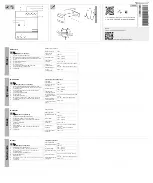
I.B. 3A74791H04
Page 23
Effective 7/97
5-4.2 SECONDARY DISCONNECTS
The circuit breaker control wiring is arranged to connect
a standard 24 point male plug with a corresponding
switchgear compartment mounted female plug. An addi-
tional 24 point plug is optional.
Type W-VAC 36kV circuit breakers utilize fixed mounted
male plugs located under the left bottom portion of the
circuit breaker truck. When two 24 point plugs are sup-
plied, they are mounted in a stacked arrangement
(Figure 5-7). Fixed mounted circuit breaker secondary
plugs connect to corresponding movable female plugs
mounted in the bottom of the switchgear compartment.
The switchgear compartment mounted secondaries are
of a movable carriage design. Once the circuit breaker
is in the TEST position, the structure mounted sec-
ondary plug carriage can be manually unlatched and
pulled forward until mating with the circuit breaker
mounted male plugs. To disengage the secondary plugs
from the TEST position, simply push the carriage to the
rear. Secondary connections are automatically engaged
or disengaged when moving into or out of the CON-
NECTED position.
5-4.3 UNDERVOLTAGE TRIP DEVICE
The undervoltage trip device for W-VAC circuit breakers
is an electromechanical device that operates to open
the circuit breaker at 35% or less of the voltage rating of
the trip coil. The device does not open the circuit break-
er at values above 70% of the voltage rating of its trip
coil. It may operate, however, to open the circuit breaker
when the voltage across the trip coil is greater than
35%, but less than 70% of the voltage rating of its trip
coil. The circuit breaker can be closed as long as the
voltage to the trip coil is maintained at 85% or above the
rated level. The undervoltage trip device is available
only as an instantaneous type with rated voltages of
48VDC, 125VDC, 250VDC 120VAC and 240VAC.
For a basic understanding of the operation of the under-
voltage trip device refer to the specific items identified in
Figure 5-8 and the following operation description.
1. With the circuit breaker closed and sufficient voltage
on the Undervoltage Trip Device coil, the moving
clapper (1) is held to the stationary yoke (2) by the
magnetic force produced by the coil (3) against the
extension springs (4) pulling the moving clapper
apart from the yoke.
2. The moving clapper is connected to the mechanism
Trip D Shaft Lever (5) by a slotted link (6).
3. When the voltage to the Undervoltage Trip Coil goes
down as described earlier, the extension springs
force overcomes the reduced magnetic force and
pulls the moving clapper up. The slotted link in turn
upsets the Trip D Shaft and the circuit breaker trips
open.
Event
Milliseconds (maximum)
Closing Time
(From Initiation of Close
75
Signal to Contact Make)
Opening Time
(Initiation of Trip Signal
45
to Contact Break)
Reclosing Time
(Initiation of Trip Signal
190
to Contact Make)
Table 5.1 Circuit Breaker Timing
Figure 5-7 Secondary Circuit Breaker Plug Shown
Mounted Lower Left
Summary of Contents for 360 W-VAC 16
Page 2: ......









































